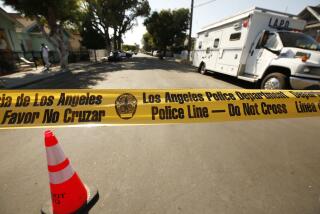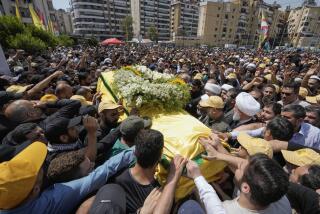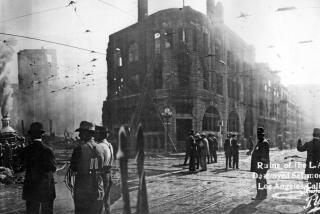Letter-Bomb Mystery Widens to U.N., London
- Share via
UNITED NATIONS — A mysterious letter-bomb campaign apparently aimed at an Arabic-language newspaper spilled into New York on Monday with the discovery of four explosive devices in the mail at the United Nations.
The U.N. scare came only hours after two security guards were injured by a letter-bomb blast at Al Hayat newspaper’s London headquarters, where four other bombs were discovered and disabled. The latest bombs appear to be part of a campaign that began Jan. 2 with the delivery of explosives to Al Hayat’s Washington office and to the federal prison at Ft. Leavenworth, Kan.
No one has claimed responsibility for the letter bombs, which all have been described as similar in size to a greeting card, bearing Egyptian stamps and an Alexandria, Egypt, postmark.
The U.N. headquarters building was partially evacuated and normal activities repeatedly were disrupted Monday by the discovery of letter bombs addressed to the Al Hayat bureau there. All of the bombs were removed and disabled by the New York Police Department bomb squad before they exploded. The bomb squad also was summoned to examine one other package that proved to be harmless.
In London, Jihad Khazen, the editor of the Saudi-owned daily, which is distributed worldwide, said that security personnel have handled the paper’s mail there since the letter bombs began to appear early this month at Al Hayat’s Washington office. But Khazen, like investigators in the U.S., Britain and the Middle East, was at a loss to explain who might be behind the campaign.
“We have no idea who did it. We haven’t been threatened, and no one has claimed responsibility,” Khazen told The Times. “We’ve been criticizing terrorism for eight years, but we haven’t picked a fight with anyone. This is the first time we have been targeted.”
In the London attack, guard Barry Roach, 46, suffered abdominal and facial injuries and could lose an eye. Fellow guard Andy MacKenzie, 35, was slightly injured.
British police suspect that the plastic explosive Semtex was enclosed in the envelopes, which like the other bombs bore Egyptian stamps and an Alexandria postmark.
The discovery of the first bomb at the United Nations forced the evacuation for more than two hours of dozens of U.N. employees and journalists from two floors of the landmark 38-story tower on Manhattan’s East Side.
*
Security officers summoned the Joint Terrorism Task Force of the FBI and the New York Police Department and the police bomb squad. The bomb squad took the device to the basement and disarmed it by inundating it with a water cannon.
The discovery prompted security officers to reexamine every piece of undelivered mail in the building, according to U.N. spokesman Fred Eckhard. That led to detection of a second device Monday evening in a subbasement mail room. The mail room and nearby offices in another subbasement were evacuated while the second bomb was disabled.
After 9:30 p.m., a third letter bomb, described by police as identical to the first two, was discovered and disarmed. Early today, police said, the fourth bomb was found, although no details were immediately available about the discovery.
The security chief at the U.N., Michael McCann, had ordered extra scrutiny of the mail Monday morning after being informed of the London attack by Raghida Dergham, Al Hayat’s U.N. correspondent.
That move paid off: One of the added security guards nabbed the first lethal letter about 20 minutes before it would have reached Dergham’s mailbox. The letter bomb, which was postmarked Dec. 21, apparently arrived at the U.N. building Friday night or Saturday and had slipped through the X-ray inspection applied to the 15,000 to 40,000 pieces of mail delivered daily.
McCann had no explanation Monday for how the bomb went through the X-ray undetected. It was not clear whether the two other bombs discovered Monday also had been subject to earlier X-ray. McCann said that security procedures would be reviewed in the wake of the breakdown. Although McCann declined to respond to questions about the quality of the equipment available to U.N. security forces, other sources inside the organization said the financially strapped world body cannot afford to bring its security apparatus up to date.
Monday’s incidents were similar to the delivery of seven letter bombs Jan. 2 to Al Hayat’s Washington office and to the federal prison at Ft. Leavenworth. All of those were disarmed before causing any injury.
Al Hayat is owned by Saudi Arabian Prince Khaled ibn Sultan ibn Abdulaziz, commander of Saudi troops during the 1991 Persian Gulf War and son of the kingdom’s defense minister. It claims a circulation of about 165,000, mainly in the Middle East, and follows a relatively independent editorial policy.
*
The origin of the letters has been a source of puzzlement in the Middle East, with various factions putting forth theories.
Initially, most speculation focused on Sunni Islamic extremists hostile to the U.S. and its chief Arab allies--Saudi Arabia and Egypt. That would include supporters of the radical Egyptian Sheik Omar Abdel Rahman, who is in prison in the United States after being convicted of conspiracy in the 1993 World Trade Center bombing. Three of his co-defendants are being held at Ft. Leavenworth.
Attempting to deflect suspicions from radical Islamic fundamentalists, one of the main London-based Saudi opposition groups, the Committee for the Defense of Legitimate Rights, issued a statement Jan. 3 blaming Libya.
Egyptian officials are skeptical that the letters were sent from Alexandria. “It’s a piece of cake to forge a stamp,” an Egyptian Interior Ministry official told The Times on condition of anonymity.
Turner reported from the U.N. and Montalbano from London. Times staff writers John Daniszewski in Cairo and Richard A. Serrano in Washington also contributed to this report.
More to Read
Sign up for Essential California
The most important California stories and recommendations in your inbox every morning.
You may occasionally receive promotional content from the Los Angeles Times.










